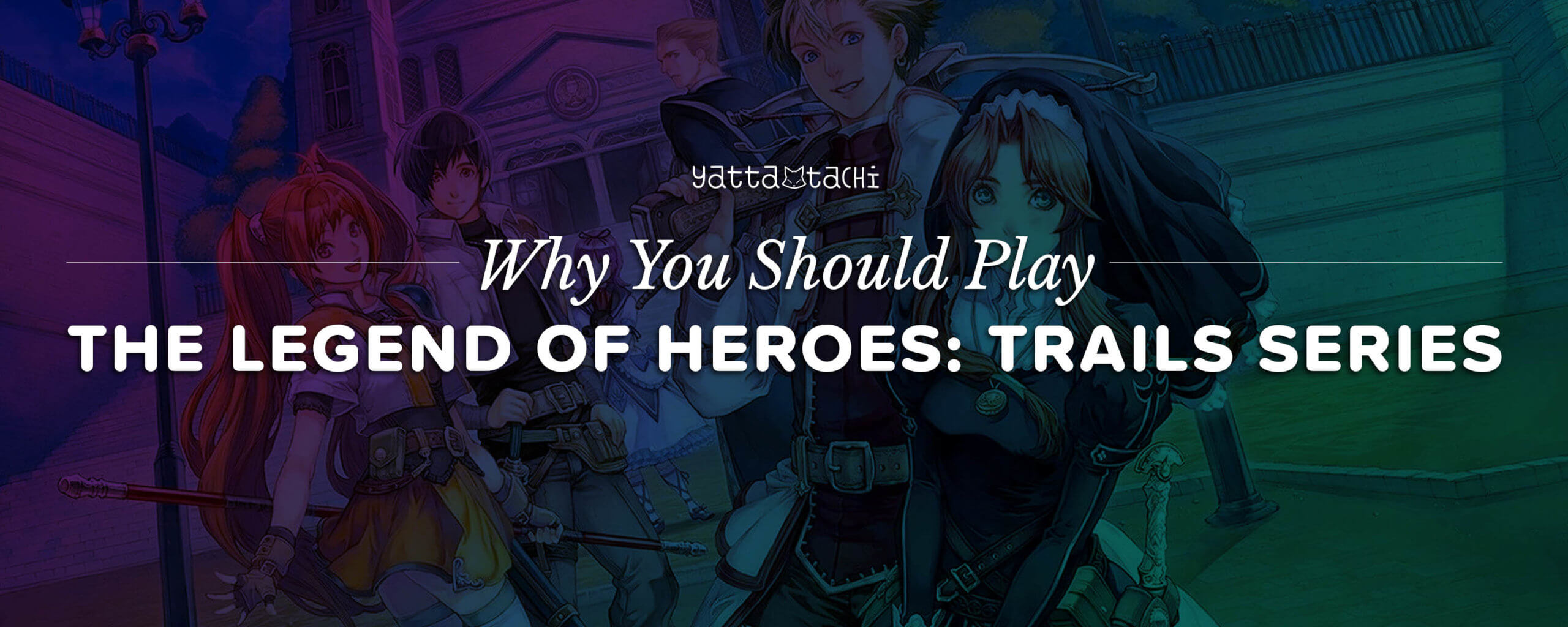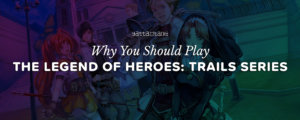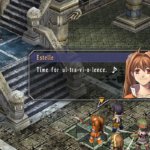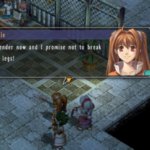How I got into the Trails game series is an interesting story. I became interested in it due to my love for Nihon Falcom’s other major series, Ys. I saw fans of Ys and other Japanese role-playing games talk about Trails so often that it was constantly on my radar. But something else about the series also caught my attention: screenshots of the protagonist of Trails in the Sky threatening to beat people up.
It was clear from screenshots such as these that the writing of the series was witty and full of charm.
Trust me when I say there is more to this series than funny lines out of context. The Trails series is a subset of Falcom’s The Legend of Heroes games. There were five titles published prior to 2004, when The Legend of Heroes: Trails in the Sky was released, marking the start of a long-running continuous story that’s still going on today.
Playing this series has made me realize something important: more people need to play it. That’s why I’m writing this article. I’ll be going over what makes the Trails series shine when it comes to its story, gameplay, and music. Hopefully, by the end of this, you will want to play this series too.
Story
The Trails continuity takes place on a continent called Zemuria, with each of the series’ main story arcs taking place in a different country. There are currently three arcs in the series, with more games still in development. These arcs are the Sky trilogy (or the Liberl arc), the Crossbell duology (or the Crossbell arc), and the Cold Steel tetralogy (or the Erebonia arc).
The Trails in the Sky trilogy takes place in Liberl and follows two young members of the Bracer Guild, an organization that takes on requests to protect the people. As they travel around the country, they solve people’s problems and learn more about the world they live in and the ancient civilizations that left an impact on it.
The Crossbell duology follows a section of the police force of Crossbell that essentially does the same thing as the Bracer Guild, while the Cold Steel games take place in a school in the empire of Erebonia. There, the students go on field trips to learn about the country they live in and hardships its people face.
World-building
One very important aspect to the Trails series that makes it more than just your average RPG is the world-building. While RPGs generally do a good job at world-building, Trails takes it to the next level.
The continent of Zemuria runs on Orbal energy. It’s used to cast Arts in battle and has had a major impact on technology across the continent, leading to mass industrialization. This is an extremely important part of the world that has large consequences on the story. But this is just the tip of the iceberg when it comes to world-building.
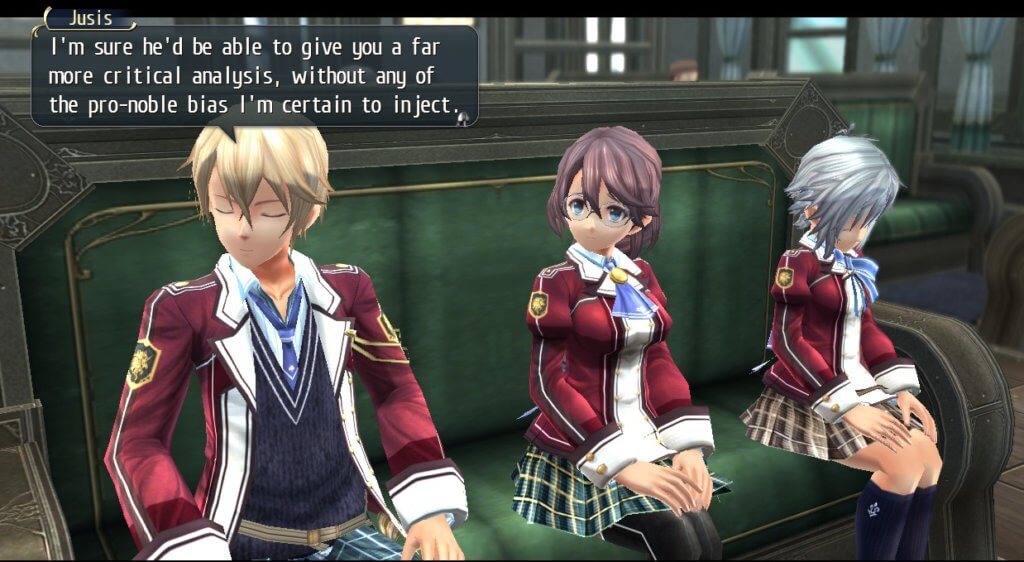
Trails is a series with a heavy focus on politics, with the setting of Zemuria revolving around it. The games have no issues going in-depth about the various political nuances of each country and city you visit. Whether it’s industrialization, agriculture, foreign affairs, taxes, war, corruption, scandals, or economics, the Trails series gives those themes attention and explains them at length. This truly makes Zemuria feel alive. The world doesn’t just revolve around the player. Instead, the player is merely an inhabitant in a place rich with lore, culture, and societal structures. The politics play an integral part in the plot of the games on top of all the other important story beats.
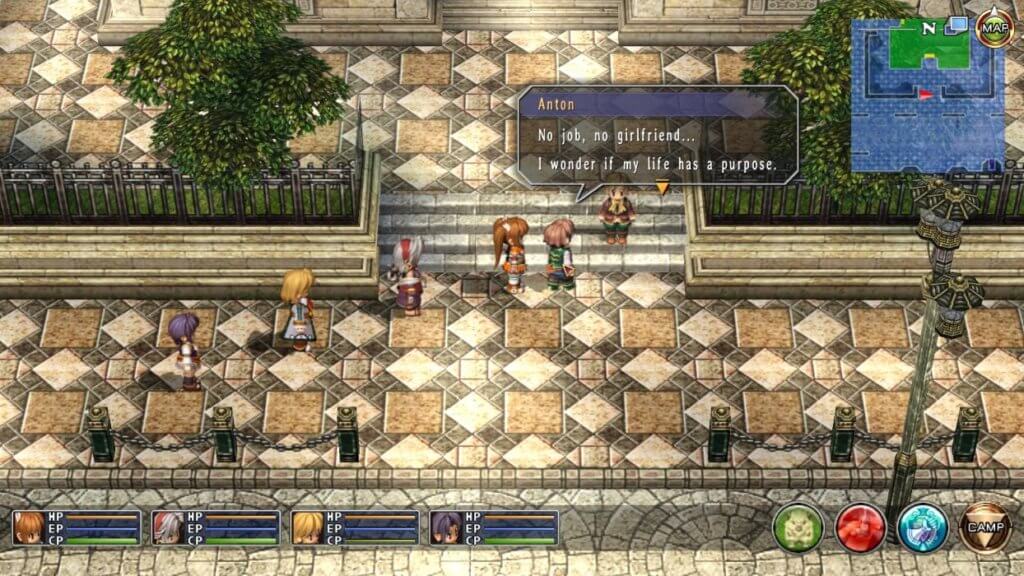
Does that level of detail seem astonishing to you? Fortunately, that’s not all. The Trails series takes an extra step to make sure the NPC (non-player character) dialogue is interesting enough to read. NPCs actually say something of importance. If you take the time to read their comments throughout the game, you’ll notice dialogue changes to reflect the events of the story, providing input that’s more than just meaningless throwaway dialogue. This attention to detail adds another layer of believability. It’s a place full of people with their own lives to live, and they are all integrated to feel like a part of the world.
Themes
The themes of the story are also interesting. Like I had stated earlier, this game is extremely political, and therefore has tons of political themes. A few examples are militarization and the military-industrial complex, war, imperialism, propaganda, government corruption, police power abuses, classism, racism, and fascism. The characters in the games provide a wide variety of perspectives on different issues. For example, some might feel the production of more dangerous weapons of war to be a terrible idea, while others find it to be completely necessary in times where the threat of war is always a fear in people’s minds.
There are also nonpolitical themes, such as personal growth and having hope in a cruel world, forgiveness and empathy, and how people have control over their own lives and can make the world a better place without the need for greater powers to control them. These themes exist to stress the importance of the journey to the player, and will likely be what ends up resonating with them.
This may seem like a lot, but they’re all fantastically woven into the series’ long-running narrative.
Gameplay
Trails is a series of turn-based RPGs, so fans of those types of games should feel right at home. But Trails mixes up the formula a bit more to make it feel unique, such as the separation of special attacks into “arts” and “crafts” (most certainly a play on the term). Arts are magic attacks that use EP (Energy Points) and have a delay before coming out. Crafts are special attacks that use CP (Craft Points). CP drains when using Crafts and increases when dealing damage or taking damage. Separating special attacks into two different types is a unique way to add depth to the combat system.
Turn Order
However, what truly makes the combat system stand out compared to other turn-based RPGs is the turn order. It’s nothing new for a turn-based RPG to have a turn order determined by the Speed stats of each party member and enemy. Trails adds an extra element to the mix while also allowing extensive manipulation of the turn order. The game has a mechanic called Delay, and each move you use has a Delay value to it. The next turn is decided by who has the lower Delay number. Normally, higher speed means lower delay for attacks. However, the game gives the player ways to delay enemies by using certain Arts or Crafts, giving the player more turns.
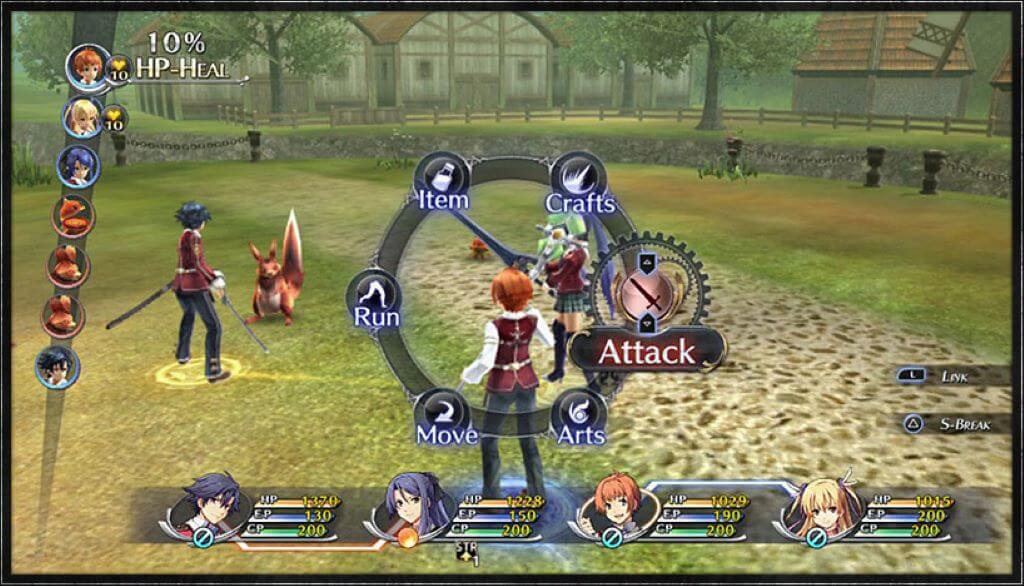
There are also turn order bonuses. On the turn order user interface menu, there are symbols at various random points. The character or enemy that acts on the turn with the bonus will receive it. By manipulating the turn order, you can reap the advantages of the turn order bonus. They give effects such as recovering HP (Hit Points), EP, and CP, or getting a guaranteed critical hit. Turn order bonuses can have contextually unique or negative effects in different situations.
Using an Art causes an automatic delay for the user because Arts take time to execute. But if the character had Fast Casting ability, they might be able to use up two turns simultaneously, which is helpful for stealing upcoming turn order bonuses. Another way is to use a character’s Craft that advances someone to the front of the turn order. The best way to take advantage of turn order bonuses is to use an S-Craft (Super Craft). An S-Craft can be activated at any time if your character has 100 CP or more, even on the enemies’ turns. Basically, you can steal turns. There are so many practical uses beyond it being each character’s ultimate attack, since the player can use it in conjunction with a critical hit bonus for a guaranteed critical hit.
Coming up with strategies to manipulate the turn order and reap turn order bonuses is key to making full use of the game’s combat system. There are many strategies and figuring them out is all part of the fun. With each game introducing new mechanics, the combat system remains fresh and deep, even when its core turn order gameplay is the same.
Customization
Another aspect that makes this game unique is the extensive amount of customization it offers. Trails has its own unique way to personalize the characters, different from other RPGs. Not only is the Orbal Energy a major part of the game’s world, it’s also ingrained into the gameplay through Orbments. These devices run on Orbal Energy and use Quartz to allow each character access to new Arts and stat increase (or decrease).
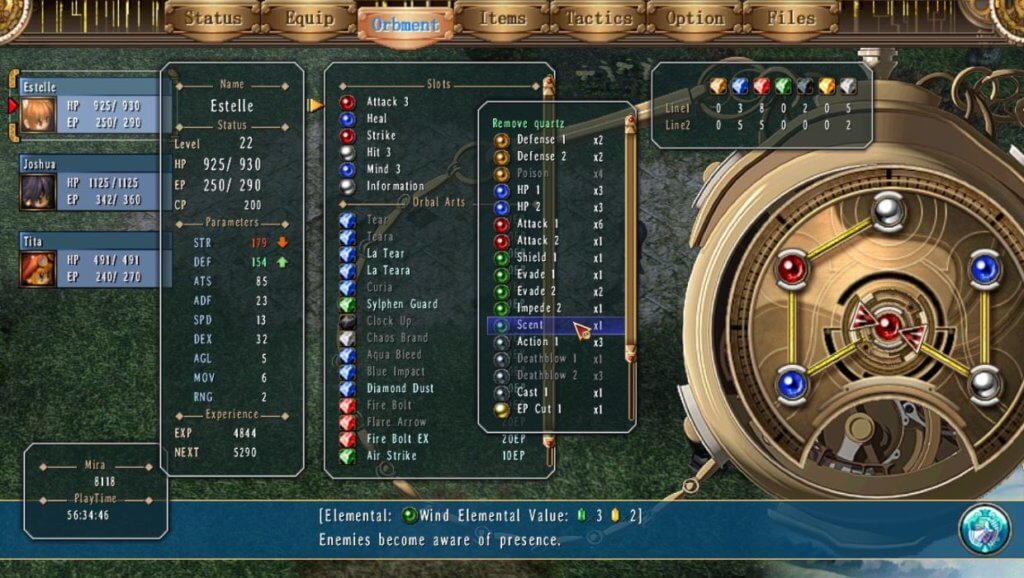
With so many options available, there is no reason not to try different setups with the various party members. Speaking of which, that’s another aspect of the series with extensive customization: there are a lot of playable characters. Normally, a large cast of party members can be seen as a detriment in RPGs, because the focus on each character gets spread thin. But Trails’ world-building gives the characters ample focus throughout the games, so the large cast size is largely justified by the story.
Moreover, each character has a distinct play style according to their weapon and Orbment. The large group of characters offers a tremendous amount of combinations for the party you decide to use. There were even about 20 party members in Trails of Cold Steel III, the game I played most recently.
If you’re a turn-based RPG enthusiast, there is so much for you to experiment with, but even if you are a newcomer, this series is still your friend. You can choose to use the same characters and not experiment much with the Orbment system if you don’t want to. The game is also very accessible with multiple difficulty options. You are able to lower the difficulty of fights you are struggling with multiple times, rather than the game gate-keeping players from advancing the story. The games also have a feature called Turbo Mode that allows you to play at super speed. You can choose to separately speed up the overworld and battle animations with it.
Music
I know what you’re thinking: Japanese RPGs always have great music! What is there to talk about? That’s what I’d think if I hadn’t played this series. I’ve been listening to Trails music nonstop for over half a year, so there has to be something great about it.
Simply put, Falcom knows how to make great music. Ask any Falcom fan and they will tell you the same thing. Trails is full of many tracks that will prove why fans know what they are talking about.
The series’ music has different styles to fit a wide variety of situations. I’m still surprised at how it’s able to have a large number of different genres that manage to feel tonally appropriate. The games have some of the best overworld and dungeon themes I’ve ever heard. Intense cutscenes are accompanied by exciting and emotionally driven music. The battle themes never fail to get me hyped, especially the boss battle compositions.
If you are a fan of rock and metal music, this series has a ton of tracks that are tailor-made for you. For fans of the violin, there is a lot to like here because Trails’ music composers make excellent use of the instrument, whether it be in its rock/metal boss themes or the more emotional songs. Most of the music in each game is digital, utilizing computerized sounds. Whether on its own or combined with real instruments, it never feels out of place.
One of my favorite songs in the series, Exceed!, is a fast-paced metal song that plays during some intense cutscenes and boss battles when a certain character unleashes his power.
Conclusion
While the Trails series can seem like a huge time commitment, it’s one worth making. Each game expands upon the lore and world-building of the previous games. The more you get into the series, the more you will want to know what happens next. Eventually, you’ll be completely absorbed into the continent of Zemuria.
This series creates the level of attachment you feel towards a long-running book series or an anime with many seasons. It’s a fully realized world you will want to know every inch of. There are many characters you will grow attached to as you embark upon epic journeys with them, journeys that are completely worthwhile.
So, what are you waiting for? There is no better time than now to start playing Trails. I highly recommend playing the games in order, starting with the first game in the series: The Legend of Heroes: Trails in the Sky.

Featured Sponsor - JAST
The sweetest romance and the darkest corruption, the biggest titles and the indie darlings; for visual novels and eroge, there's nowhere better.
Big thank you to our supporters
From their continous support, we are able to pay our team for their time and hard work on the site.
We have a Thank-You page dedicated to those who help us continue the work that we’ve been doing.
See our thank you page